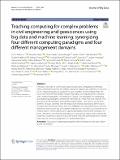| dc.contributor.author | Babović, Zoran | |
| dc.contributor.author | Bajat, Branislav | |
| dc.contributor.author | Barac, Dusan | |
| dc.contributor.author | Bengin, Vesna | |
| dc.contributor.author | Đokić, Vladan | |
| dc.contributor.author | Đorđević, Filip | |
| dc.contributor.author | Drašković, Dražen | |
| dc.contributor.author | Filipović, Nenad | |
| dc.contributor.author | French, Stephan | |
| dc.contributor.author | Furht, Borko | |
| dc.contributor.author | Ilić, Marija | |
| dc.contributor.author | Irfanoglu, Ayhan | |
| dc.contributor.author | Kartelj, Aleksandar | |
| dc.contributor.author | Kilibarda, Milan | |
| dc.contributor.author | Klimeck, Gerhard | |
| dc.date.accessioned | 2023-06-06T19:11:47Z | |
| dc.date.available | 2023-06-06T19:11:47Z | |
| dc.date.issued | 2023-05-31 | |
| dc.identifier.uri | https://hdl.handle.net/1721.1/150864 | |
| dc.description.abstract | Abstract
This article describes a teaching strategy that synergizes computing and management, aimed at the running of complex projects in industry and academia, in the areas of civil engineering, physics, geosciences, and a number of other related fields. The course derived from this strategy includes four parts: (a) Computing with a selected set of modern paradigms—the stress is on Control Flow and Data Flow computing paradigms, but paradigms conditionally referred to as Energy Flow and Diffusion Flow are also covered; (b) Project management that is holistic—the stress is on the wide plethora of issues spanning from the preparation of project proposals, all the way to incorporation activities to follow after the completion of a successful project; (c) Examples from past research and development experiences—the stress is on experiences of leading experts from academia and industry; (d) Student projects that stimulate creativity—the stress is on methods that educators could use to induce and accelerate the creativity of students in general. Finally, the article ends with selected pearls of wisdom that could be treated as suggestions for further elaboration. | en_US |
| dc.publisher | Springer International Publishing | en_US |
| dc.relation.isversionof | https://doi.org/10.1186/s40537-023-00730-7 | en_US |
| dc.rights | Creative Commons Attribution | en_US |
| dc.rights.uri | http://creativecommons.org/licenses/by/4.0/ | en_US |
| dc.source | Springer International Publishing | en_US |
| dc.title | Teaching computing for complex problems in civil engineering and geosciences using big data and machine learning: synergizing four different computing paradigms and four different management domains | en_US |
| dc.type | Article | en_US |
| dc.identifier.citation | Journal of Big Data. 2023 May 31;10(1):89 | en_US |
| dc.contributor.department | Massachusetts Institute of Technology. Laboratory for Information and Decision Systems | |
| dc.contributor.department | Lincoln Laboratory | |
| dc.identifier.mitlicense | PUBLISHER_CC | |
| dc.eprint.version | Final published version | en_US |
| dc.type.uri | http://purl.org/eprint/type/JournalArticle | en_US |
| eprint.status | http://purl.org/eprint/status/PeerReviewed | en_US |
| dc.date.updated | 2023-06-04T03:11:08Z | |
| dc.language.rfc3066 | en | |
| dc.rights.holder | The Author(s) | |
| dspace.embargo.terms | N | |
| dspace.date.submission | 2023-06-04T03:11:08Z | |
| mit.license | PUBLISHER_CC | |
| mit.metadata.status | Authority Work and Publication Information Needed | en_US |
